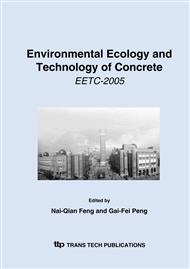p.584
p.591
p.595
p.603
p.610
p.618
p.624
p.630
p.637
Prediction of Crack Width of Chloride Contaminated Reinforced Concrete Structures
Abstract:
Crack width is a significant parameter for assessing service life of reinforced concrete structures in chloride-laden environments. Corrosion-induced concrete cracking is a predominant causal factor influencing premature degradation of reinforced concrete structures, incurring considerable costs for repairs and inconvenience to the public due to interruptions. This gives rise to the need for accurate prediction of crack width in order to achieve cost-effectiveness in maintaining serviceability of concrete structures. It is in this regard that the present paper attempts to develop a quasi-brittle mechanical model to predict crack width of chloride contaminated concrete structures. Assuming that cracks be smeared uniformly in all directions and concrete be a quasi-brittle material, the displacement and stress in a concrete cover, before and after surface cracking, were derived respectively in an analytical manner. Crack width, as a function of the cover depth, steel bar diameter, corrosion rate and time, was then determined. Finally, the analysis results were verified by comparing the solution with the experimental results. The effects of the cover depth, steel bar diameter and corrosion rate on the service life were discussed in detail.
Info:
Periodical:
Pages:
610-617
Citation:
Online since:
January 2006
Authors:
Keywords:
Price:
Сopyright:
© 2006 Trans Tech Publications Ltd. All Rights Reserved
Share:
Citation:


